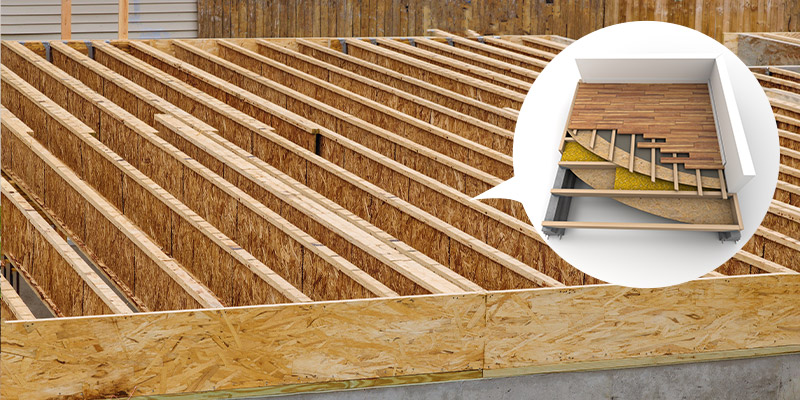
What are the Different Types of Floor Insulation Methods?
Insulating your floors can reduce heat loss of up to 15%, this is quite significant when you consider your energy bills and home temperature. However, floor insulation is usually one of the last types of insulation that is carried out, with it often being overlooked. Well, we’re here to tell you some great methods of floor insulation that can help you save money on energy bills and help you prepare for those cold winters ahead. Before we dive into discussing the different methods of floor insulation, we advise that you check out our previous article on identifying the different types of floors and how you can assess whether they are already insulated or not.
Now that you understand your type of floor, we can suggest some viable insulation methods that can provide the desired outcome for your home to benefit you and/or your family.
Methods of Floor Insulation
1. Above Floor Insulation
Above floor insulation is, in its simplest form, just using a rug or carpeting. Yes, let’s start at the basics. Just by adding carpeting or a rug above your floors, you can notice a significant difference in insulation, providing a quick and easy, yet temporary solution to floor insulation. At best, a good rug or carpet can prevent some of your draught, which is definitely better than stepping out onto cold floors.
2. Draught-Proofing Floor Insulation
Now we are getting a bit more technical. Draught proofing your floorboards can help reduce draughts that are carried throughout your home, presenting an unideal living space. You can add this form of floor insulation simply by filling any gaps in your wooden floors using a sealant or caulking. If your home has suspended floors, then draughts can easily pickup and create an unpleasant atmosphere across your home.
3. Insulation Under the Carpet
Placing insulation underneath carpets can also provide sufficient insulation for your home, this additional layer can help prevent draughts, warm up your home and create an overall better place to live. Specific insulation that can help with this is a polyfoam board or fibreboard.
4. Underfloor Insulation
If you are able to access underneath your floorboards, your floor insulation process just became a lot easier. You can insulate the space without having to remove floorboards construct underfloor insulation with boards.
How to Insulate Different Types of Floors?
Concrete Floor Insulation
Using either a floor slab or underneath insulation in the case that your floor is being redone, you can be sure to effectively insulate the area. You can use high-performance insulation boards which offer thermal resistance, draught-proofing, money saving and can warm up your rooms much quicker when you are using the heating.
Using an insulation board for your floor slabs do run the risk of increasing height to your floors, making other areas of your room distort, such as door, shelves and cupboard heights. Additionally, you will need to be cautious of any building regulations at this stage.
You can, however, avoid this by opting in for insulation with your floor being redone, and you can more easily integrate and control the insulation of your floors.
Wooden Floor Insulation
Like many homes, if your floorboards are wooden, then you are open to various insulation methods to sufficiently insulate your home. We previously mentioned the use of sealant to block the gaps in the floorboard, while this can help, heat loss also occurs through the floor material, and therefore your floors will still not be effectively insulated.
When installing floor insulation to wooden floors, an inspection is necessary to assess any risk and danger involved. Floorboards must meet a certain standard before insulation can be installed. If there is significant rotting, mould, or other issues then they will need to be first addressed. Additionally, any insulation carried out will also need to consider the implications of ventilation, make sure the area is still well ventilated.
When you do begin the insulation process, some effective materials can be to install insulation boards or mineral fibre. This fibre can be placed in between the floor’s joists, creating a more thermally effective area. Fibres can also be fire resistant as well, adding other benefits to having floor insulation.
If your wooden floors are not accessible via going underneath, then the only choice will be to remove the floorboards. Therefore, we recommend combining your floor insulation with your floor renovation and advise to get your floors insulated when you are considering and wanting a floor renovation, in order to avoid constant replacing of floorboards.
Using Spray Foam for Floor Insulation
Yes, spray foam insulation can even insulate your floorboards. This insulation product is a top-of-the-range service and can accommodate for most, if not all, of your insulation needs. Due to the irregularities that lie underneath floorboards, it is easy for insulation not to cover all the necessary nooks and crannies. However, when using open-cell spray foam insulation you can make sure that it fits and expands in all areas. This lightweight form of insulation can spread across your desired area, making sure it covers what is necessary.
Benefits of Using Spray Foam for Undefloor Insulation
- Sound-deadening properties
- Lasts as long as the building
- Superior thermal performance
- Prevents mould growth
- Increases structural integrity
- Expanding foam covers all nooks and crannies
- Saves you money on energy bills
- Can increase property value
Floor Insulation the Right Way
If you are interested in floor insulation or discussing your options for having your floors insulated, then you can contact us today online or call us directly on 0203 411 5188 and our team of certified insulation experts can recommend the best course of action for you and your home.


